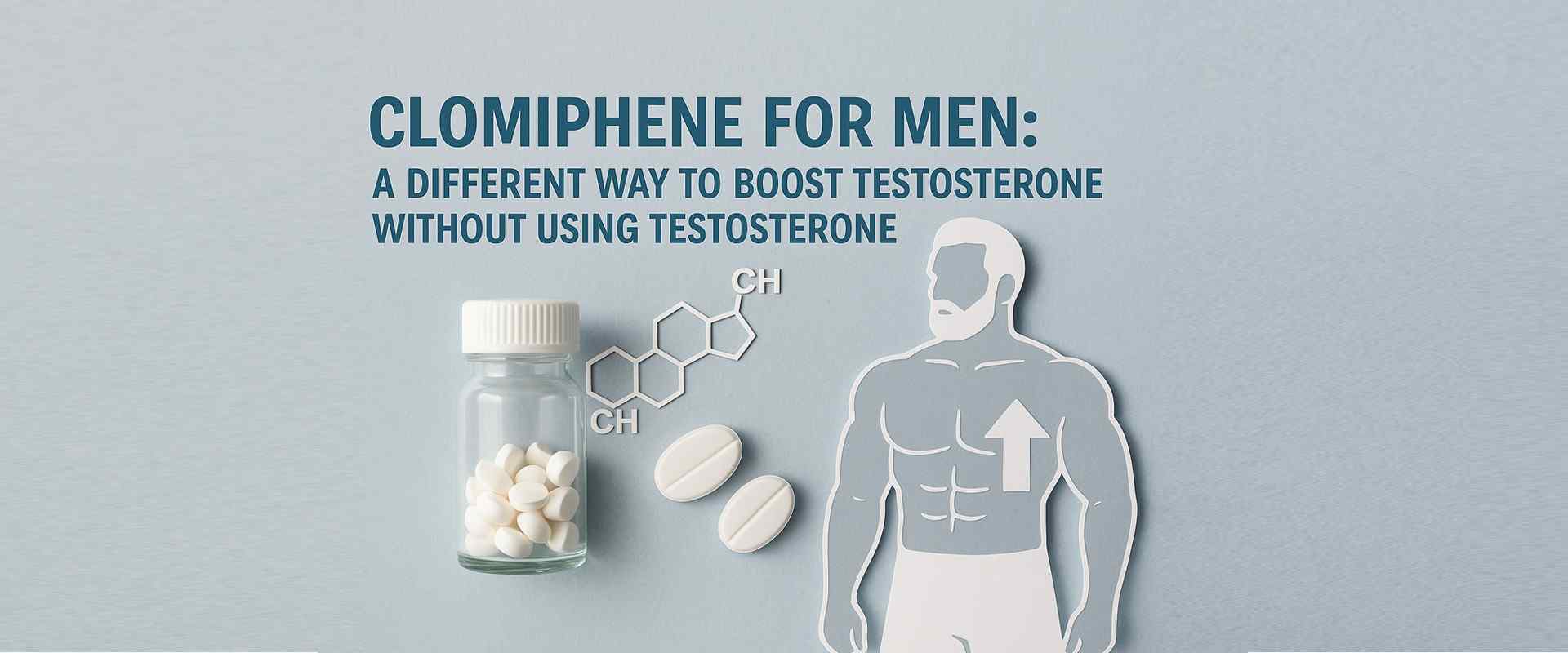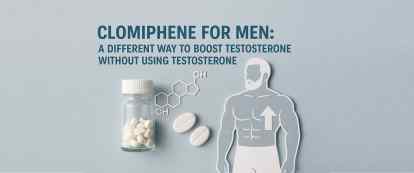Clomiphene for Men: A Non-Testosterone Approach to Boosting T Levels

Testosterone plays a crucial role in a man’s energy, mood, strength, and sexual health. But not all men with low testosterone ("Low T") are ready or eligible for testosterone replacement therapy (TRT). For younger men or those wanting to preserve fertility, there's another option: clomiphene citrate.
Clomiphene, commonly known by the brand name Clomid, was originally used to treat infertility in women. However, it has gained popularity among healthcare providers as an off-label treatment for men with low testosterone levels, especially those with secondary hypogonadism.
How It Works
Clomiphene doesn't replace testosterone in the body. Instead, it works by stimulating the brain's hormonal control center—the hypothalamus and pituitary gland. These parts of the brain act like a thermostat, constantly measuring hormone levels and signaling the body to produce more or less as needed.
When clomiphene is introduced, it blocks estrogen receptors in the hypothalamus, essentially "tricking" the brain into thinking there isn't enough estrogen (which is partially made from testosterone). In response, the hypothalamus sends stronger signals to the pituitary gland, which then increases the release of two key hormones:
- Luteinizing hormone (LH) – Stimulates the Leydig cells in the testes to produce testosterone
- Follicle-stimulating hormone (FSH) – Supports sperm production and testicular function
The result is a natural increase in testosterone levels without shutting down the body’s own production system. This mechanism makes clomiphene especially attractive for men who want to avoid the testicular shrinkage and fertility suppression that often come with direct testosterone therapy. It's a way of restarting the body’s own hormonal engine rather than supplying it from the outside.
Clomiphene may be a great option for a variety of men dealing with hormone imbalances, especially those seeking a more natural or fertility-friendly solution to low testosterone.
Ideal candidates include:
- Younger men with low T: Particularly those in their 20s to 40s who may still want to have children or who are just beginning to experience symptoms of testosterone decline.
- Men with secondary hypogonadism: In this condition, the issue lies not in the testes but in the brain's signaling—specifically low LH and FSH. Clomiphene helps correct that upstream signaling.
- Men wanting to preserve fertility: Unlike testosterone therapy, which can suppress sperm production, clomiphene encourages the testes to continue producing both sperm and testosterone.
- Men looking for a non-injection option: Clomiphene is taken orally, making it appealing for men who want to avoid needles, gels, or transdermal applications.
- Men with functional causes of low T: This includes men whose testosterone levels have dropped due to stress, poor sleep, excess body fat, overtraining, or medications—situations where the endocrine system may still be capable of bouncing back with the right support.
Clomiphene is not a one-size-fits-all solution, but it offers a versatile and often underutilized tool for men whose hormone production may be disrupted but not permanently damaged.
A typical starting dose of clomiphene is 25 to 50 mg every other day, though some men may require dose adjustments depending on how they respond to treatment. Some providers may even begin with lower doses to assess tolerance and gradually increase based on clinical outcomes.
Regular monitoring includes:
- Total and free testosterone
- Estradiol (E2)
- LH and FSH
- Symptoms and side effects
This helps fine-tune the dose and catch any imbalances early.
Pros:
- Boosts natural testosterone production
- Preserves sperm production and fertility
- Oral (no needles or gels)
- Lower risk of testicular shrinkage compared to TRT
Cons:
- Delayed onset of benefits: Clomiphene takes time to stimulate the body's natural production of hormones, so it may take 3–6 weeks or longer to begin noticing improvements in symptoms such as energy, libido, or mood.
- Potential side effects: Some men may experience mood swings, irritability, or blurred vision. Though uncommon, visual disturbances (such as seeing flashes or floaters) can be a reason to stop the medication and consult a physician.
- Not effective for all types of low T: Clomiphene works best for secondary hypogonadism. In cases of primary hypogonadism, where the testes are no longer responsive to LH and FSH signals, clomiphene may not be effective and traditional testosterone therapy might be required.
Yes. Some doctors combine clomiphene with other therapies to enhance results and better balance hormones:
- hCG (human chorionic gonadotropin): hCG mimics LH and further stimulates the testes, helping to preserve or even increase testicular size, sperm production, and natural testosterone output. It's especially helpful in men who show signs of testicular shrinkage or who are actively trying to conceive.
- Aromatase inhibitors (like anastrozole): Clomiphene can sometimes increase estradiol levels, especially in men with higher body fat or sensitivity to estrogen. Aromatase inhibitors help block the conversion of testosterone to estradiol, keeping estrogen levels in check and minimizing side effects like mood swings, water retention, or gynecomastia (breast tissue development).
- Lifestyle interventions: Clomiphene is most effective when paired with foundational lifestyle strategies. Weight loss, stress management, regular exercise, quality sleep, and a clean diet can all help support hormone balance and improve the body’s response to treatment. Addressing inflammation, blood sugar control, and micronutrient deficiencies (like zinc or vitamin D) may further enhance testosterone production.
This integrative approach supports the body’s own hormone system from multiple angles, helping men achieve more consistent, lasting results.
While clomiphene is a safe and effective therapy for many men, it isn’t suitable for everyone. Some situations may call for alternative treatment approaches:
- Men with testicular failure (primary hypogonadism): If the testes are no longer able to respond to LH and FSH signals—such as from injury, radiation, or congenital issues—clomiphene will not be effective. These men often require direct testosterone replacement.
- Men with high LH/FSH levels: Elevated LH and FSH can indicate that the pituitary is already working hard to stimulate the testes, but the testes aren’t responding. In this case, clomiphene may offer no additional benefit.
- Men with a history of mood disorders or vision problems: Although uncommon, clomiphene has been associated with mood swings, irritability, and visual side effects like blurred vision or floaters. Men with preexisting conditions in these areas may be at increased risk for worsening symptoms.
- Men needing rapid symptom relief: Clomiphene works by stimulating the body to produce its own testosterone, which can take several weeks. Men experiencing severe symptoms who need fast-acting treatment may respond better to direct testosterone therapy.
- Men who are not adherent to regular lab monitoring: Because clomiphene therapy requires ongoing testing to ensure hormonal balance and avoid complications (like excess estradiol), it may not be appropriate for individuals who cannot commit to regular follow-ups.
Clomiphene offers a smart, personalized option for boosting testosterone naturally. It’s especially useful for younger men or those wishing to maintain fertility. If you're exploring options for low T, talk to a hormone-trained provider about whether clomiphene is the right fit for you.



